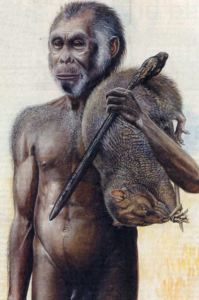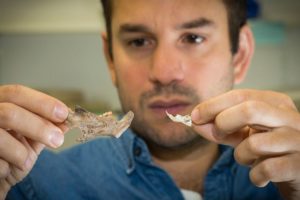An international team of researchers led by Griffith University discovered the arrival of ancient humans to uninhabited islands doesn’t always lead to widespread extinctions as is often thought.

Homo floresiensis huntingthe giant rats found on theNusa Tenggara islands in Indonesia that persisted for tens of thousands of years after human arrival. Image: Peter Schouten
Published in Proceedings of National Academy of Sciences, the research team examined archaeological and paleontological records of all islands inhabited by humans over the last 2.6 million years, finding they weren’t always destructive agents and their arrival often had minimal impacts on biodiversity loss.
“We have this picture that as soon as people arrive in a new ecosystem, they cause untold amounts of damage” said led researcher Associate Professor Julien Louys, from the Australian Research Centre for Human Evolution, “but we found that this was only the case for the most recent human arrivals on islands.”
Archaeologists and palaeontologists who work on islands with prehistoric records met in 2017 to compared records of human arrival and extinctions on islands spanning the past 2.6 million years, finding very little overlap between the two events.
“Based on classic cases of island extinction from the more recent past, we expected that mass extinction should shortly follow island colonisation. But, when we examined the data, there were very few cases where this could be demonstrated,” Associate Professor Louys said.
“Even in cases where there was a close link between human arrival and island extinctions, these could not be disentangled from records of environmental change brought about by global climatic events and changing sea levels.”
The team also recorded several examples of human ancestor extinctions and instances where humans had to abandon islands.
“The unique ecological conditions that drive island extinctions definitely didn’t spare humans either,” said Professor Sue O’Connor of the Australian National University, the senior researcher on the study.

Led researcher Associate Professor Julien Louys, from the Australian Research Centre for Human Evolution, looking at giant rat fossils
“Island ecosystems are some of the most at risk in the world today and understanding the past impacts of people on these environments is critical for safeguarding their future.”
Associate Professor Louys said our results show that the successful colonisation of islands does not necessarily require wholesale destruction of ecosystems.
“It is only more recently, with advanced technologies, translocation of exotic species, and human population increases that we begin to see massive detrimental effects of humans on island ecosystems.
“By studying the cases where people lived on islands for thousands of years without tipping these fragile ecosystems off balance, we might gain valuable insights into how they can be better managed today.”

